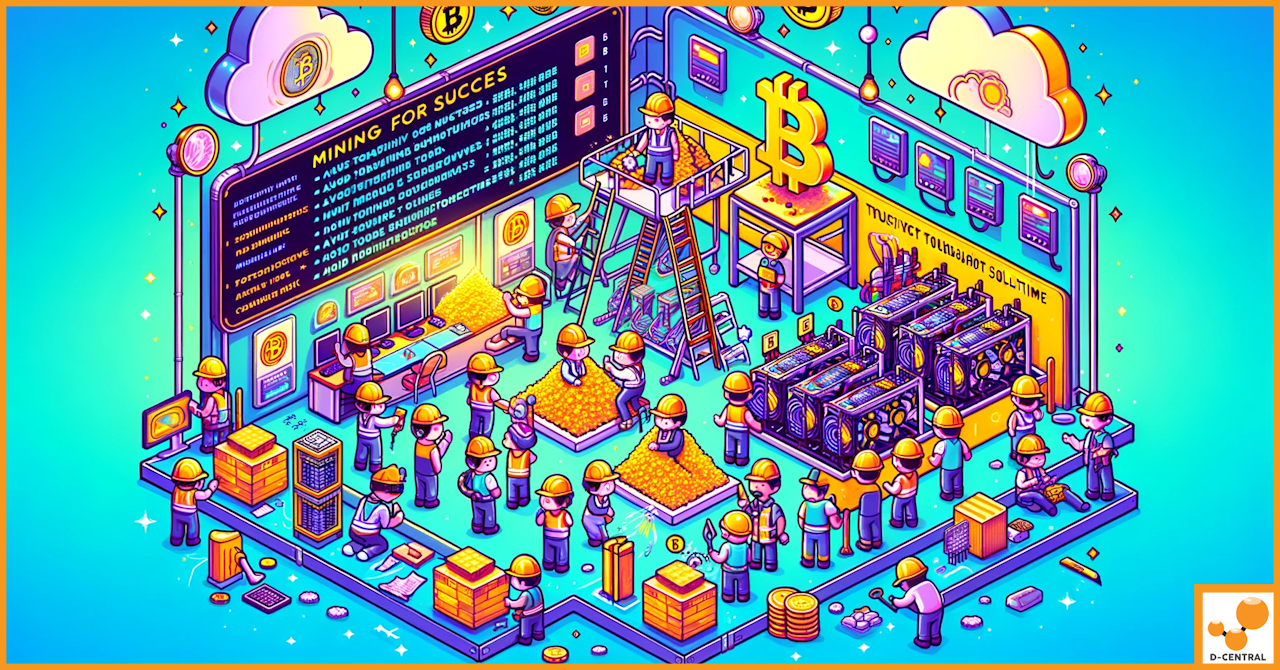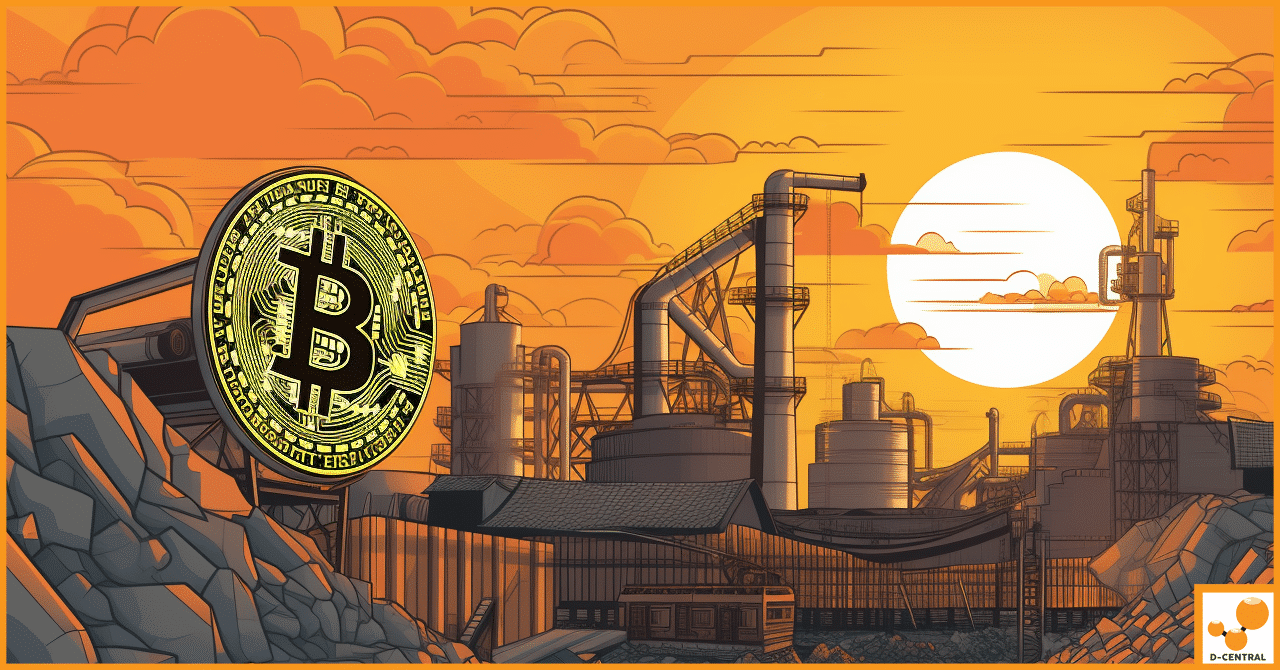
Mining for Success: How to Avoid and Troubleshoot Downtime
Bitcoin mining stands as a cornerstone of the cryptocurrency world, a process that not only introduces new bitcoins into circulation
4479 Desserte Nord Autoroute 440, Laval, QC H7P 6E2

In the early hours of a seemingly ordinary day, the ground beneath Taiwan trembled with a force strong enough to send ripples of concern across the globe. This was not just any tremor but the island’s strongest earthquake in nearly a quarter-century, striking at the heart of the global tech supply chain. Taiwan, a small island nation, commands an outsized role in the semiconductor industry, home to the Taiwan Semiconductor Manufacturing Company (TSMC), the world’s premier chipmaker. These chips are the lifeblood of myriad technologies, from smartphones and laptops to the specialized rigs mining Bitcoin, the digital gold of the 21st century.
The event spotlighted the fragile thread upon which the digital age hangs. A significant disruption at TSMC could have cascaded through the global economy, marking what financiers and economists call a “Black Swan” – an unpredictable event with potentially severe consequences. This earthquake tested the resilience of this critical node in the global technology network, reminding us of the thin ice on which the digital era skates, especially in niche but rapidly growing sectors like Bitcoin mining. The reliance on Taiwan’s semiconductor output is a known vulnerability in the global tech ecosystem, yet its potential impact, magnified by this seismic event, caught many off guard.
In the shadow of this natural disaster, the term “Black Swan” looms large. Originally coined to describe an event that is beyond normal expectations and has potentially severe consequences, it perfectly encapsulates the precarious situation that arose in Taiwan. The earthquake’s timing and location brought to light the tightrope walk of global chip supply chains, emphasizing how a single incident could disrupt the global market for crucial components in various technologies, especially those as niche and as power-intensive as Bitcoin mining rigs.
In the aftermath, the tech world exhaled a collective sigh of relief as TSMC quickly assessed and mitigated the immediate dangers, averting a crisis that could have sent shockwaves through markets and industries reliant on its output. Yet, the episode serves as a stark reminder of the ever-present risk of “Black Swan” events in our interconnected and technologically dependent world.
At the core of the global technology industry lies Taiwan’s semiconductor sector, a powerhouse of innovation and manufacturing that has become indispensable to the modern world. Leading this charge is the Taiwan Semiconductor Manufacturing Company (TSMC), a titan whose influence stretches across continents, industries, and gadgets of every kind. From the smartphones in our pockets to the servers powering the cloud, TSMC’s chips are foundational to our digital existence.
TSMC isn’t just a participant in the semiconductor industry; it’s a linchpin that holds the global technology ecosystem together. As the world’s largest contract chipmaker, TSMC manufactures semiconductors for companies that design their own chips but lack the advanced facilities to produce them. This model has made TSMC a critical partner for tech giants like Apple, AMD, and Qualcomm, among others. Its foundries are where the theoretical meets the tangible, turning innovative chip designs into the physical processors that power everything from consumer electronics to advanced computing systems.
One of the more niche yet increasingly significant areas reliant on TSMC’s capabilities is Bitcoin mining. This sector demands high-performance chips for mining rigs, devices designed to secure the Bitcoin network and process transactions. The efficiency and power of these rigs often determine the profitability of mining operations, with TSMC’s advanced semiconductors enabling the next generation of mining hardware. The company’s role in producing ASICs (Application-Specific Integrated Circuits) specifically designed for cryptocurrency mining underscores its influence on the financial technology landscape.
The numbers behind TSMC’s operations are staggering. With a market share that dwarfs its closest competitors, TSMC is responsible for manufacturing over 50% of the world’s semiconductors. This dominance is a testament to its technological prowess, operational scale, and strategic partnerships. In 2020, TSMC announced plans to invest $100 billion over the next three years to expand its manufacturing capacity and advance its technology — a clear indication of its commitment to maintaining its lead in the semiconductor race.
TSMC’s importance to global technology supply chains cannot be overstated. In a world increasingly driven by digital technologies, the demand for semiconductors is soaring. TSMC’s foundries are at the forefront of meeting this demand, pushing the boundaries of what’s possible in silicon and securing the future of technology.
In summary, TSMC’s dominance in the semiconductor industry is a critical factor in the global tech ecosystem’s health and growth. Its role in powering devices and technologies, from consumer gadgets to Bitcoin mining rigs, underscores the strategic importance of Taiwan’s semiconductor sector. As we navigate the complexities of the digital age, the resilience, innovation, and capacity of companies like TSMC will continue to be central themes in the story of technology’s evolution.
In the early hours of a day marked for posterity, Taiwan was rocked by its most significant seismic event in nearly a quarter of a century. The earthquake, with its epicenter located just south of Hualien City, unleashed a magnitude of 7.4 (as measured by the U.S. Geological Survey), sending shockwaves through the heart of the island and beyond. Occurring before 8 a.m. local time, it not only disrupted the daily lives of millions but also posed an immediate threat to the nerve center of the global semiconductor industry.
The tremor’s magnitude and proximity to key technological and industrial hubs ignited immediate concerns over the potential impact on semiconductor production facilities, particularly those of TSMC, a company integral to the global tech supply chain. The fears were not unfounded; a significant disruption in TSMC’s operations could have had cascading effects on global electronics production, affecting everything from consumer electronics to specialized Bitcoin mining hardware.
TSMC’s response to the earthquake was swift and systematic. Despite the early hour, evaluations began immediately to assess the extent of the damage and ensure the safety of all personnel. The company reported sporadic evacuations and minor machine damage but was quick to reassure stakeholders that the impact on operations would be minimal. This prompt action underscored the robustness of TSMC’s emergency preparedness and its ability to maintain continuity in the face of natural disasters.
Other tech companies in the region followed suit, conducting their own assessments and taking necessary precautions to safeguard their operations and employees. The collective response from Taiwan’s tech industry highlighted a well-coordinated effort to mitigate the earthquake’s impact, emphasizing the resilience and preparedness that have become hallmarks of the sector.
The earthquake served as a stark reminder of the vulnerabilities inherent in the global supply chain, particularly in regions prone to natural disasters. However, the swift and effective response by TSMC and other companies demonstrated a commitment to resilience and adaptability. This event, while testing the mettle of Taiwan’s semiconductor industry, ultimately reinforced its strength and preparedness, ensuring that what could have been a “Black Swan” event for global tech production remained a challenge successfully navigated.
The recent earthquake in Taiwan, though largely navigated with precision and minimal disruption, threw into sharp relief the potential vulnerabilities of the global semiconductor supply chain. A pivotal player in this narrative is TSMC, whose facilities are instrumental not just to general tech manufacturing but crucially to the niche market of Bitcoin mining. Let’s delve into the potential scenarios and consequences if fortune had not favored the resilient.
Had the earthquake inflicted significant damage on TSMC and other semiconductor facilities, the immediate fallout could have been catastrophic for global electronics markets. TSMC’s leading edge in chip fabrication is not easily replicable; any long-term outage would create a vacuum, causing supply shortages across a multitude of sectors reliant on advanced semiconductors. From smartphones and computing devices to the servers that form the backbone of the internet, the ripple effects would be felt worldwide.
Nowhere would this impact be more acutely felt than in the Bitcoin mining industry. Mining rigs, specialized hardware designed to secure blockchain transactions and mint new bitcoins, depend on high-performance, energy-efficient ASICs produced by manufacturers like TSMC. A significant production halt could lead to a scarcity of mining hardware, driving up costs and potentially slowing the rate at which new bitcoins are created. For an industry that thrives on the edge of technological advancement, this could mean a significant setback, hampering growth and innovation.
The hypothetical damage to TSMC’s facilities would further exacerbate existing supply chain issues, deepening the tech world’s woes. Over the past years, the industry has been grappling with unprecedented demand coupled with supply constraints due to various factors, including the global pandemic. A significant disruption in chip production would not only extend lead times for electronics but also inflate prices, affecting consumers and industries alike.
In the context of Bitcoin mining, where the optimization of cost per computation is crucial for profitability, any increase in hardware costs or delay in upgrading mining rigs could disrupt the delicate balance of mining economics. It would not only affect individual miners but also large-scale mining operations that rely on a steady influx of the latest hardware to stay competitive.
Thankfully, the swift and effective response from TSMC and the resilience of Taiwan’s semiconductor infrastructure meant that such dire scenarios remained hypothetical. The episode is a testament to the critical importance of disaster preparedness and risk management in the global tech industry. As we move forward, the lessons learned will undoubtedly shape future strategies to fortify the semiconductor supply chain against potential black swan events, ensuring the stability and continuity of global tech production, including the vital niche of Bitcoin mining.
The realm of Bitcoin mining is a niche yet crucial sector within the broader cryptocurrency ecosystem, fundamentally reliant on cutting-edge semiconductor technology. The essence of Bitcoin mining lies in the operation of specialized hardware known as ASIC miners. These devices, which are at the heart of mining operations, depend heavily on advanced semiconductors designed for high efficiency and performance. The fabrication of these ASIC chips is a testament to the technological prowess of companies like TSMC, underscoring the semiconductor industry’s pivotal role in sustaining and advancing Bitcoin mining activities.
In a hypothetical scenario where an event like the recent Taiwan earthquake could have caused significant disruptions to semiconductor production facilities, the Bitcoin mining sector would face immediate and pressing challenges. Supply constraints would likely lead to a cascade of effects, including:
Industry experts highlight several potential long-term impacts on Bitcoin mining if major disruptions to chip production were to occur. Among these are:
In conclusion, while the recent earthquake in Taiwan did not significantly disrupt semiconductor production, the potential for such an event highlights a vulnerability in the Bitcoin mining sector. The reliance on a stable, uninterrupted supply of advanced semiconductors is a critical issue that warrants attention and strategic planning to mitigate risks and ensure the long-term sustainability of Bitcoin mining operations.
The recent earthquake in Taiwan, occurring near the hub of the global semiconductor industry, held the potential to trigger a widespread disruption across the tech world. This event prompted a collective holding of breath among stakeholders, from the giants of consumer electronics to the specialized niche of Bitcoin mining. Fortunately, the resilience of the semiconductor industry, exemplified by swift action and minimal damage at TSMC, allowed for a collective sigh of relief as a major crisis was averted.
This near-miss serves as a potent reminder of the importance of anticipating and preparing for “Black Swan” events within the global technology supply chain. Such events, characterized by their unpredictability and potential for significant impact, underscore the need for robust contingency planning and the diversification of supply chains to mitigate risks.
The semiconductor industry, particularly through the lens of this incident, demonstrates a commendable level of resilience and adaptability. Its critical role in supporting not just mainstream technology but also emerging sectors like Bitcoin mining cannot be overstated. The industry’s ability to navigate potential disasters ensures the continuous advancement of technology, highlighting the imperative for ongoing investment in disaster preparedness and infrastructure resilience.
Looking ahead, the lessons learned from this event will undoubtedly shape future strategies within the tech industry, fostering a culture of resilience that can support the rapid pace of innovation and the increasing reliance on semiconductor technology. As the industry continues to evolve, its stakeholders must remain vigilant, ensuring that the backbone of our digital world can withstand the challenges that lie ahead, thereby securing the future of emerging technologies like Bitcoin mining.
What significance does Taiwan hold in the global semiconductor industry?
Taiwan is central to the global semiconductor industry, significantly due to the presence of the Taiwan Semiconductor Manufacturing Company (TSMC), which is the world’s leading chipmaker. TSMC’s advanced semiconductor production capabilities are foundational for various global technologies, including consumer electronics, cloud computing, and Bitcoin mining rigs.
What is a “Black Swan” event in the context of the global tech industry?
A “Black Swan” event in the global tech industry refers to an unpredictable occurrence that has potentially severe consequences. For example, the recent earthquake in Taiwan was considered a potential “Black Swan” event due to its capacity to disrupt the critical semiconductor manufacturing operations at facilities like TSMC, which could have cascaded through the global economy.
How did the recent earthquake in Taiwan impact the semiconductor industry?
The recent earthquake in Taiwan, despite its potential to cause substantial disruptions, saw minimal impact on the semiconductor industry, thanks to quick and effective responses by companies like TSMC. Their preparedness and resilience ensured continued operations with only minor damages reported, averting a significant crisis for the global tech ecosystem.
What role does TSMC play in Bitcoin mining?
TSMC plays a critical role in Bitcoin mining by producing the advanced semiconductors required for ASIC (Application-Specific Integrated Circuits) miners. These high-performance, energy-efficient chips are essential for the profitability and operation of Bitcoin mining rigs, making TSMC’s contributions pivotal for the cryptocurrency mining sector.
What could have been the global implications if TSMC had been severely affected by the earthquake?
Had TSMC been severely affected by the earthquake, the global implications could have been far-reaching, affecting not just the semiconductor supply chain but also various sectors reliant on advanced chips, including consumer electronics and Bitcoin mining. It could have led to increased costs, delayed expansions, and potentially exacerbated the centralization within the Bitcoin mining industry.
How does the semiconductor industry’s resilience benefit emerging sectors like Bitcoin mining?
The semiconductor industry’s resilience, as demonstrated by its response to the Taiwan earthquake, benefits emerging sectors like Bitcoin mining by ensuring a stable supply of advanced chips essential for mining operations. This stability supports the continuous innovation and growth within the sector, safeguarding it against potential disruptions and sustaining its economic viability.
DISCLAIMER: D-Central Technologies and its associated content, including this blog, do not serve as financial advisors or official investment advisors. The insights and opinions shared here or by any guests featured in our content are provided purely for informational and educational purposes. Such communications should not be interpreted as financial, investment, legal, tax, or any form of specific advice. We are committed to advancing the knowledge and understanding of Bitcoin and its potential impact on society. However, we urge our community to proceed with caution and informed judgment in all related endeavors.
Related Posts

Bitcoin mining stands as a cornerstone of the cryptocurrency world, a process that not only introduces new bitcoins into circulation

In the ever-evolving world of digital finance, Bitcoin has emerged as a revolutionary force, reshaping our understanding of currency, transactions,

In the digital realm, Bitcoin has emerged as a revolutionary force that has redefined the concept of currency. Born out